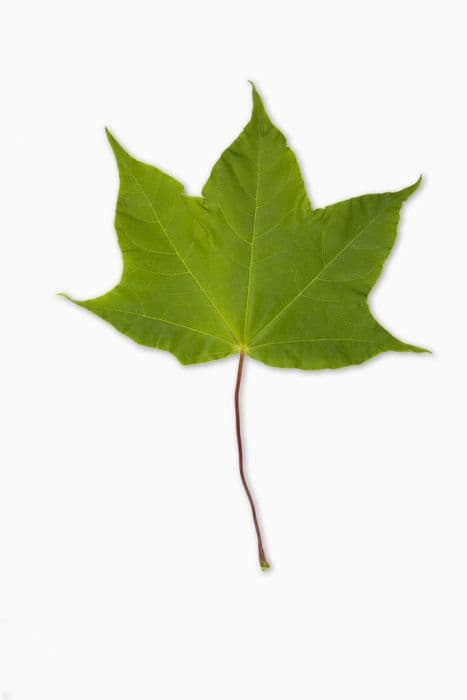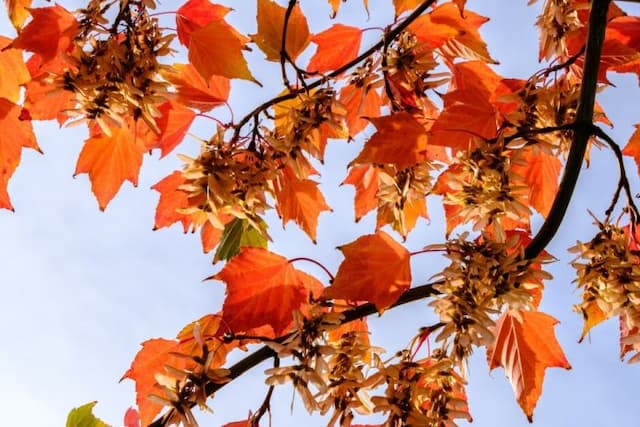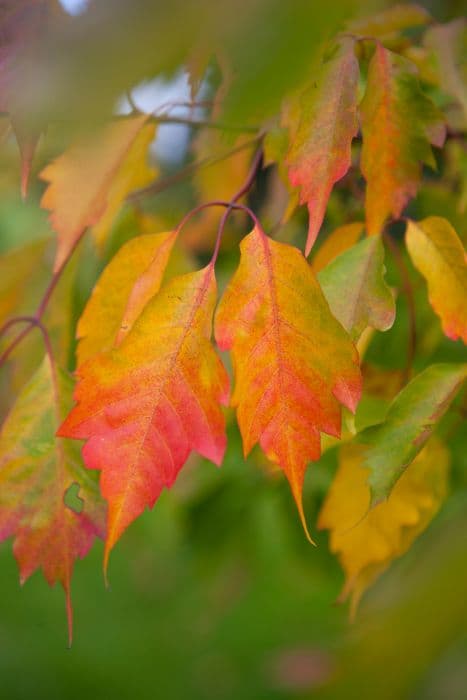Horse chestnut Aesculus hippocastanum 'Wisselink'

ABOUT
The Aesculus hippocastanum 'Wisselink', also known as the Horse Chestnut 'Wisselink', is a striking and decorative tree. It is characterized by its palmate leaves, which means the leaves are arranged in a manner similar to the fingers on a hand extending from the palm. Each of these leaves is comprised of several elongated leaflets, radiating from a central point, and they boast a rich green color that brings a lush appearance to the tree. The foliage often turns to a warm, golden brown during the fall, offering a seasonal display of color. One of the most beautiful aspects of this tree is its flowers. The Horse Chestnut 'Wisselink' produces impressively large, pyramidal clusters of creamy white flowers, each with a small red spot. These blooms are highly ornamental and are a magnet for bees and other pollinators when they appear in the spring. Once the flowering season is over, the tree produces its distinctive fruit: rounded, spiny capsules containing shiny brown seeds commonly known as conkers, which are traditionally collected by children for play in some cultures. The tree's bark is another point of interest, as it is usually flaky and can be quite textured, ranging in color from a light gray to a slightly pinkish-brown hue. The overall structure of the Horse Chestnut 'Wisselink' is evenly branched, creating a rounded canopy that makes it a handsome and picturesque presence in any garden or landscape where it is featured. It is worth noting, however, that despite its ornamental qualities, the nuts produced by the tree should not be consumed by humans as they contain a compound that can be toxic. Overall, the Horse Chestnut 'Wisselink' is a majestic and attractive deciduous tree, celebrated for its stunning foliage, beautiful blooms, and striking presence.
About this plant
 Names
NamesFamily
Sapindaceae
Synonyms
Wisselink Horse Chestnut, Wisselink Aesculus
Common names
Aesculus hippocastanum 'Wisselink'.
 Toxicity
ToxicityTo humans
The horse chestnut is considered toxic to humans. All parts of the plant contain various toxins, including saponins and glycosides, which can be harmful if ingested. Symptoms of horse chestnut poisoning can include nausea, vomiting, diarrhea, abdominal pain, dizziness, and in severe cases, depression of the central nervous system, which can potentially lead to respiratory failure and arrest. Medical attention should be sought if ingestion occurs.
To pets
Horse chestnut is also toxic to pets, such as dogs and cats. The same chemical compounds responsible for toxicity in humans, mainly saponins and glycosides, are present in all parts of the plant and can cause adverse effects in pets. Symptoms of poisoning in pets may include vomiting, diarrhea, depression, weakness, and dilated pupils. In severe cases, it can lead to muscle twitching, respiratory problems, and even paralysis. Contact a veterinarian immediately if you suspect your pet has ingested any part of the horse chestnut plant.
 Characteristics
CharacteristicsLife cycle
Perennials
Foliage type
Deciduous
Color of leaves
Green
Flower color
White
Height
50-75 feet (15.2-22.9 meters)
Spread
40-70 feet (12.2-21.3 meters)
Plant type
Tree
Hardiness zones
5-7
Native area
Balkans
Benefits
 General Benefits
General Benefits- Shade provider - The large canopy of the horse chestnut provides ample shade, making it suitable for parks and large gardens.
- Aesthetic appeal - With its showy flowers and lush foliage, the horse chestnut adds ornamental value to any landscape.
- Wildlife habitat - The tree attracts a variety of wildlife, including bees and birds, which find food and shelter in its branches.
- Seasonal interest - The horse chestnut offers visual interest throughout the year with its spring flowers, summer foliage, and autumn nuts.
- Urban tolerance - This species can tolerate urban pollution and poor soils, making it a resilient choice for city landscaping.
- Erosion control - The extensive root system can help stabilize soil and control erosion on slopes.
- Wood uses - Wood from the horse chestnut is used for furniture and other woodcraft due to its workability and fine grain.
 Medical Properties
Medical Properties- Venous insufficiency: The seeds of the horse chestnut, from which Aesculus hippocastanum 'Wisselink' is cultivated, contain a compound called aescin which has been used to improve venous blood flow, reduce leg swelling, and alleviate symptoms of varicose veins.
- Anti-inflammatory: Aescin also displays anti-inflammatory properties which make it useful in the treatment of conditions like hemorrhoids and postoperative edema.
- Antioxidant: Horse chestnut extract has antioxidant compounds which could help in protecting cells from damage caused by free radicals.
 Air-purifying Qualities
Air-purifying QualitiesThis plant is not specifically known for air purifying qualities.
 Other Uses
Other Uses- Water purification: Horse chestnut extracts can be used to remove heavy metals from water due to their chelating properties.
- Biodegradable soaps: The saponins present in horse chestnut can act as natural detergents and are used in making biodegradable soaps and cleaning products.
- Photographic film developing: The high content of tannins in horse chestnuts can be used as an alternative fixer in the photographic film developing process.
- Livestock feed: Horse chestnut seeds are sometimes processed to remove toxins and can be used as a supplementary livestock feed under controlled conditions.
- Natural dye: The bark and leaves of horse chestnuts can be used to make natural dyes for textiles and crafting purposes.
- Leather tanning: Tannins extracted from horse chestnut can be used in the tanning process of leather goods.
- Furniture polish: Oils from horse chestnut can be used in formulations for furniture polishes and wood conditioners.
- Composting activator: The leaves of horse chestnut are rich in minerals and when composted, they can act as a 'composting activator', speeding up the decomposition process.
- Seed crafts: Horse chestnut seeds can be used in a variety of crafts, such as making necklaces, ornaments, or children's crafts like conker animals.
- Plant-based starch: Starch can be extracted from horse chestnut seeds and used in cooking or as an ingredient in natural adhesives.
Interesting Facts
 Feng Shui
Feng ShuiThe Horse Chestnut is not used in Feng Shui practice.
 Zodiac Sign Compitability
Zodiac Sign CompitabilityThe Horse Chestnut is not used in astrology practice.
 Plant Symbolism
Plant Symbolism- Strength: Commonly known as the Horse Chestnut, Aesculus hippocastanum has been associated with strength due to its robust nature and its hardy wood.
- Endurance: The resilience of the Horse Chestnut tree to withstand various environmental factors symbolizes endurance.
- Prosperity: The conkers (seeds) of the Horse Chestnut are sometimes carried as tokens believed to bring wealth and prevent financial loss.
- Healing: Historically, parts of the Horse Chestnut tree have been used in medicine, leading to its association with healing properties.
- Memory and Intelligence: Due to the brain-like shape of the Horse Chestnut seed, it sometimes represents mental faculties.
 Water
WaterHorse chestnut trees, which is the common name for Aesculus hippocastanum 'Wisselink', should be watered deeply but infrequently to encourage a strong root system. Young trees benefit from watering once a week with about 15-25 gallons of water, depending on the soil type and weather conditions. Mature trees are relatively drought-tolerant and may only need supplemental water during extended periods of dry weather. In the absence of rain, watering every two to three weeks is usually sufficient, adjusting for particularly hot or dry conditions which may necessitate more frequent watering.
 Light
LightHorse chestnut trees prefer a position where they receive full sun to partial shade. They thrive best with exposure to at least four to six hours of direct sunlight daily, but they can tolerate light shade, especially during the heat of the afternoon. It is optimal to plant them in a spot that gets morning sun and dappled shade in the afternoon to protect them from the intense, potentially harmful heat.
 Temperature
TemperatureHorse chestnuts are hardy trees, tolerating a wide range of temperatures; they can survive winter cold down to around -20°F and summer heat up to about 100°F. For robust growth, they favor temperatures that remain consistently between 50°F and 85°F. Avoiding exposure to extreme temperatures beyond this range is ideal to ensure the health and longevity of the tree.
 Pruning
PruningThe Horse chestnut should be pruned to remove dead or diseased branches, to thin out dense growth, and to shape the tree. It's best to prune in late winter or early spring before the tree breaks dormancy. Pruning should be done yearly, especially for young trees to establish the desired form and clear out any problematic branches. Some light pruning can also be done in summer, if necessary, to remove any branches damaged by storms or wind.
 Cleaning
CleaningAs needed
 Soil
SoilHorse chestnut 'Wisselink' thrives in a well-draining loamy soil, enriched with organic matter like compost. A slightly acidic to neutral pH range of 6.0 to 7.5 is ideal for this tree to flourish.
 Repotting
RepottingHorse chestnut 'Wisselink' does not require frequent repotting and is typically only repotted when significantly root-bound due to its eventual large size and is often planted directly in the ground.
 Humidity & Misting
Humidity & MistingHorse chestnut 'Wisselink' is tolerant of a wide range of humidity levels and does not have specific humidity requirements, which makes it well-suited for varied outdoor environments.
 Suitable locations
Suitable locationsIndoor
It's impractical to grow horse chestnut 'Wisselink' indoors due to its size.
Outdoor
Plant in full sun to partial shade, ensure adequate space for growth.
Hardiness zone
4-7 USDA
 Life cycle
Life cycleAesculus hippocastanum 'Wisselink', commonly known as the 'Wissel's Sycamore', starts its life as a seed, typically sown in the autumn, which will then stratify over winter before germinating in the spring. Upon germination, it enters a growth phase, developing a taproot and foliage through spring and into summer. The tree continues its vegetative growth for several years, establishing a robust trunk and branching system. After reaching maturity, which can take 10-20 years, it begins to flower annually in the spring, displaying showy panicles of white flowers with a small red spot. Following pollination, the flowers develop into spiny fruits containing large, brown seeds known as conkers, which will fall to the ground in autumn, ready to start the cycle anew if conditions are suitable. The mature tree enters a period of maintenance, where growth slows and it may live for many decades, possibly over 200 years, continuing to cycle through seasonal growth, flowering, and fruiting phases.
 Propogation
PropogationPropogation time
Spring to Early Summer
The Aesculus hippocastanum 'Wisselink', commonly known as the Horse Chestnut, is generally propagated by seeds. The most popular method is to collect seeds, which are the large, shiny, brown nuts often found beneath the trees in autumn. For successful germination, the seeds require a period of cold stratification, which simulates winter conditions. This can be achieved by placing the seeds in a sealed bag with slightly moist sand or a similar medium and then storing them in a refrigerator for approximately 2 to 3 months. Once stratified, the seeds can be sown in a cold frame or outdoors in well-drained soil in spring. Seedlings usually appear within a few weeks to a couple of months and can be grown on before being planted in their final location.









